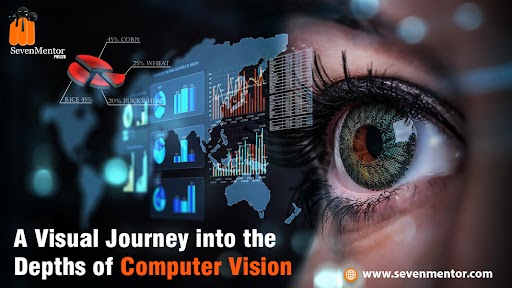A Visual Journey into the Depths of Computer Vision
Hey, this is Suraj. Today is the world of AI. Computer vision is an interdisciplinary field of study that focuses on enabling machines to see, interpret, and understand images and videos. It involves the development of algorithms and techniques that allow computers to extract information from digital images and videos and make decisions based on that information.

Here are some key concepts and techniques you should be familiar with when learning computer vision:
Image Processing: Image processing involves manipulating images to improve their quality or extract useful information. Some common image processing techniques include filtering, thresholding, and edge detection. Feature Extraction: Feature extraction involves identifying key characteristics in an image that can be used to identify or classify objects. Some popular feature extraction techniques include SIFT, SURF, and HOG.
For Free, Demo classes Call: 020-71177359
Registration Link: Click Here!
Object Detection: Object detection involves locating and identifying objects within an image or video. Some popular object detection techniques include Haar Cascades, Faster R-CNN, and YOLO. Image Segmentation: Image segmentation involves dividing an image into different regions or segments based on their visual characteristics. This can be useful for identifying objects within an image or separating foreground and background. Convolutional Neural Networks (CNNs): CNNs are a type of deep learning algorithm that is commonly used in computer vision tasks. They are inspired by the structure and function of the human brain and are designed to automatically learn features from images. Join our Artificial Intelligence classes in Pune and delve into the fascinating world of AI.
Applications of Computer Vision: Computer vision has many practical applications, including facial recognition, self-driving cars, medical image analysis, and surveillance systems.
Image Classification: Image classification involves assigning a label or category to an image based on its visual content. This can be accomplished using supervised learning techniques such as convolutional neural networks.
Image Retrieval: Image retrieval involves finding images in a database that are similar to a given query image. This can be useful for applications such as reverse image search.
Optical Character Recognition (OCR): OCR involves automatically recognizing and interpreting text in images. This can be useful for applications such as digitizing documents or extracting information from images.
For Free, Demo classes Call: 020-71177359
Registration Link: Click Here!
Augmented Reality (AR): AR involves overlaying digital information onto the real world using a camera or other visual input. AR applications often use computer vision techniques to identify and track objects in the environment.
Self-driving Cars: Self-driving cars use computer vision to identify objects such as pedestrians, other vehicles, and road signs. Computer vision algorithms can also be used to analyze sensor data and make real-time decisions based on the surrounding environment.
Security and Surveillance: Computer vision can be used in security and surveillance systems to detect and track objects or people in real time. For example, video surveillance cameras can use computer vision algorithms to automatically detect suspicious behavior and alert security personnel.

Medical Imaging: Medical imaging uses computer vision algorithms to analyze images such as X-rays, MRIs, and CT scans. Computer vision can help identify anomalies and assist with diagnosis and treatment.
3D Computer Vision: 3D computer vision involves reconstructing and understanding the three-dimensional structure of the world from images or video. This can be useful for applications such as robotics, virtual reality, and autonomous vehicles.
To learn computer vision, you can start by studying the fundamental concepts and techniques mentioned above. You can also try experimenting with open-source computer vision libraries such as OpenCV, TensorFlow, or PyTorch. Additionally, participating in computer vision competitions or building your own projects can help you gain practical experience and improve your skills. Unlock the power of AI by joining SevenMentor’s Artificial Intelligence Course in Pune.
Deep Learning: Deep learning is a subfield of machine learning that involves the use of neural networks with many layers to automatically learn features from data. Deep learning has revolutionized computer vision in recent years, allowing for more accurate and complex models.
If you found this blog interesting, be sure to check out the next blog, where we will explore the role of AI in other industries and how it is changing the way we live and work.
Do visit our channel to learn more: Click Here
Thank you for reading, and we hope to see you in your next blog post!
Author:
Suraj Kale
Call the Trainer and Book your free demo Class For Artificial Intelligence Call now!!!
| SevenMentor Pvt Ltd.
© Copyright 2021 | SevenMentor Pvt Ltd.

